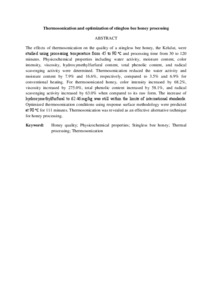Citation
Chong, K. Y. and Chin, N. L. and Yusof, Y. A.
(2017)
Thermosonication and optimization of stingless bee honey processing.
Food Science and Technology International, 23 (7).
608 - 622.
ISSN 1082-0132; ESSN: 1532-1738
Abstract
The effects of thermosonication on the quality of a stingless bee honey, the Kelulut, were studied using processing temperature from 45 to 90 ℃ and processing time from 30 to 120 minutes. Physicochemical properties including water activity, moisture content, color intensity, viscosity, hydroxymethylfurfural content, total phenolic content, and radical scavenging activity were determined. Thermosonication reduced the water activity and moisture content by 7.9% and 16.6%, respectively, compared to 3.5% and 6.9% for conventional heating. For thermosonicated honey, color intensity increased by 68.2%, viscosity increased by 275.0%, total phenolic content increased by 58.1%, and radical scavenging activity increased by 63.0% when compared to its raw form. The increase of hydroxymethylfurfural to 62.46 mg/kg was still within the limits of international standards. Optimized thermosonication conditions using response surface methodology were predicted at 90 ℃ for 111 minutes. Thermosonication was revealed as an effective alternative technique for honey processing.
Download File
![[img]](http://psasir.upm.edu.my/63567/1.hassmallThumbnailVersion/Thermosonication%20and%20optimization%20of%20stingless%20bee%20honey%20processing.pdf)  Preview |
|
Text (Abstract)
Thermosonication and optimization of stingless bee honey processing.pdf
Download (214kB)
| Preview
|
|
Additional Metadata
Actions (login required)
 |
View Item |

